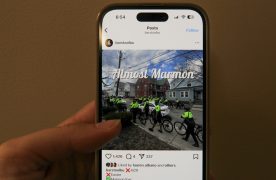Along with posts from friends’ vacations and weekend outings, Instagram feeds are often filled with celebrities and social media influencers. “The Bachelor” contestants, bloggers and Insta-famous profiles are constantly posting pictures that endorse one product or the other. Advertisements for hair vitamin gummies or teeth whitening products are always popping up, but sometimes Instagram users can easily confuse a real post for an advertisement.
Celebrities, most notably the Kardashian clan, create posts to sponsor brands but don’t clearly specify that they’re being paid to make the post. Though the hashtag #ad or #sponsored is needed if they’re being compensated, users often save those hashtags to be the last in a long line of others. Sometimes followers have to actively seek out the information of paid content. This has made it hard for Instagram users to differentiate paid sponsorship from non-sponsored content.
The Federal Trade Commission has tried to crack down on these brands that have celebrity endorsers or sponsorship. New regulations include having to do more than just thank the brand or use the full word “sponsored” instead of the condensed “sp” or “spons.” These are attempts to create more awareness and transparency within advertising, as the age of social media has blurred certain lines that need to become more defined.
Many Instagram users don’t realize right away what is and what isn’t an advertisement. #Sp doesn’t clarify a sponsored post, which should be clearly labeled. It seems like advertisements often slip through the cracks of what is ethical. Product placement is an additional example that isn’t well-defined. While Coca-Cola’s partnership with “American Idol” is known to most viewers, other shows and music videos don’t have the option for a caption clarifying that they’re being paid to include a certain product or brand name. Paid articles often shown on websites or apps can also confuse viewers if the writer or sponsor aren’t identified well enough. Though product placement, sponsored news articles and paid Instagram posts are clearly different, all fundamentally make users question their integrity.
Even if a post’s caption clearly sounds like advertised content or a script straight from the company itself, viewers still have a right to know exactly what celebrities and bloggers are being paid for. These influencers are trusted highly by some fans and it’s essential to know when they’re being paid to endorse a product rather than if they endorse it on their own terms. When famous social media users offer a recommendation, it should be clear if they’re recommending it based on their personal experiences or if they’re doing it because they’re being compensated. This isn’t to say all sponsored content is bad, because it can be effective for many brands. The problems only arise when celebrities and brands aren’t being straightforward about their exchange, whether it be money or goods. No celebrity, blogger or Insta-famous person should attempt to hide branded content.
The blame shouldn’t be put completely on the sponsors. While celebrities like Mark Wahlberg, Bella Thorne and Chris Pratt, to name a few, haven’t been completely clear in their posts, they’re not truly at fault. These Instagram users are just the face of the company for a few posts. Any company trusting their branding to a third-party source will be very specific in how they handle it. Oftentimes, the captions of sponsored posts are already given to each user. The FTC should be watching companies more closely.
In a world of fake news and severe distrust of the media, the FTC must crack down on vague advertisements. Instagram users must know the distinction between an ad and real content and have that information readily available. It’s unethical for companies to be allowed to present paid advertising as earned media. Different levels of media literacy mean that while millennials and older generations might understand the differentiation, younger kids won’t be able to understand the concept. It’s hard for them to realize that a celebrity’s life on Instagram and Facebook isn’t the same as their real lives. And it isn’t fair for companies to take advantage of a lack of media literacy by hiding their ads behind notorious faces. Straightforward and transparent advertising is not only preferred, but necessary.
Advertising is essentially meant to sell a lifestyle. This makes Instagram a perfect platform, as images show the lives these celebrities and influencers live. But if they truly aren’t using these products and supporting these brands, they’re not living that life. All Instagram users deserve to easily understand that distinction and not be fooled by it.













